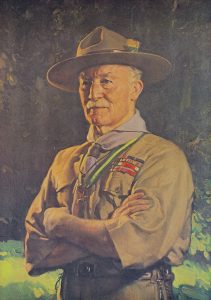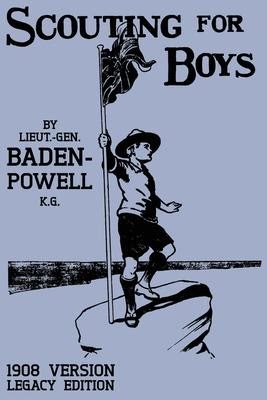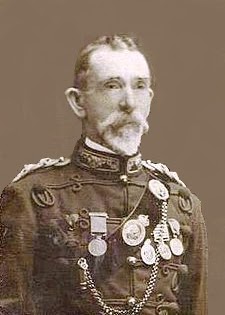What is Scouting?

The man who became known as B-P, the founder of Scouting, was born Robert Stephenson Smyth Baden-Powell in London on February 22, 1857, the son of an Oxford University professor.
The eighth of ten children, B-P was only three years old when his father died, leaving his mother, Henrietta Powell, to bring up the family on her own.
B-P got his early education from his mother, but he later won a scholarship to Charterhouse School in Godalming, Surrey, UK, founded in 1611 and one of Britain’s most prestigious public (private) schools. Henrietta encouraged her children to make their own fun, and the young B-P was always eager to learn new skills, picking up both the piano and violin.
At Charterhouse, he began to turn his attention to the great outdoors, hiding out in the woods around the school to track wildlife, and even catch and cook rabbits, being careful not to let the tell-tale smoke give his position away.
During the holidays, the young adventurer would head out with his brothers in search of adventure. On one occasion, they went sailing around the south coast of England. On another, they paddled up the the River Thames by canoe to its source. All the time, Baden-Powell was learning the crafts and skills that were to prove so useful to him in later life.
B-P wasn’t known for being one of the most academically-minded of schoolboys, but when he took the entrance exam for the army he came in second of the several hundred applicants and was commissioned straight into the 13th Hussars, bypassing the officer training that was the usual route into the cavalry regiment. He later became their Honorary Colonel
The man who became known as B-P, the founder of Scouting, was born Robert Stephenson Smyth Baden-Powell in London on February 22, 1857, the son of an Oxford University professor.
The eighth of ten children, B-P was only three years old when his father died, leaving his mother, Henrietta Powell, to bring up the family on her own.
B-P got his early education from his mother, but he later won a scholarship to Charterhouse School in Godalming, Surrey, UK, founded in 1611 and one of Britain’s most prestigious public (private) schools. Henrietta encouraged her children to make their own fun, and the young B-P was always eager to learn new skills, picking up both the piano and violin.
At Charterhouse, he began to turn his attention to the great outdoors, hiding out in the woods around the school to track wildlife, and even catch and cook rabbits, being careful not to let the tell-tale smoke give his position away.
During the holidays, the young adventurer would head out with his brothers in search of adventure. On one occasion, they went sailing around the south coast of England. On another, they paddled up the the River Thames by canoe to its source. All the time, Baden-Powell was learning the crafts and skills that were to prove so useful to him in later life.
B-P wasn’t known for being one of the most academically-minded of schoolboys, but when he took the entrance exam for the army he came in second of the several hundred applicants and was commissioned straight into the 13th Hussars, bypassing the officer training that was the usual route into the cavalry regiment. He later became their Honorary Colonel.
Military Life
In 1876, B-P headed to India with his new regiment. As a young army officer, he specialised in scouting, map-making and reconnaissance, and soon began to train the other soldiers in what were essential skills for any soldier of the time. B-P’s methods were unorthodox. He set up small units or patrols who worked together under a single leader, and made sure there was special recognition for those who did well. The proficiency badges he awarded then resembled the traditional design of the north compass point, and today’s universal Scout badge remains remarkably similar.
After India, B-P found himself in the Balkans, South Africa and Malta. But it was his return to Africa at the start of the Second Boer War that made his reputation. Now a Lieutenant-General, B-P found himself the leader of a British garrison defending the town of Mafeking against some 5,000 Boer soldiers. B-P and his men managed to give the impression the town was far more heavily guarded than it actually was, holding off the Boers for 217 days until reinforcements finally arrived. The siege allowed B-P to truly test his scouting skills, and the courage and ingenuity shown by the young soldiers at Mafeking made a lasting impression on him.
Returning home in 1903, B-P discovered that he had become a national hero. He also found that the small handbook he had written for soldiers, Aids to Scouting, was being used by youth leaders and teachers all over the country to teach observation and woodcraft.
His newfound fame led to invitations to speak at meetings and rallies across Britain, and while at a Boys’ Brigade gathering the group’s founder Sir William Smith asked B-P to devise a scheme to improve citizenship training for boys.
 Beginnings of the Scout Movement
Beginnings of the Scout Movement
B-P immediately set to work. He reworked Aids to Scouting for a younger audience, and in 1907 organised what’s known as the “experimental” camp on Brownsea Island, in Poole Harbour off the coast of Dorset, UK, to put some of his ideas into practice. He brought together 22 boys – some wealthier children from private schools and some from ordinary working class homes – and took them camping. It was the start of the Scout Movement; an event now commemorated with a foundation stone on the island.
Scouting for Boys was published the following year in six fortnightly parts and proved more successful than anyone expected. Boys followed B-P’s suggestions and formed themselves into Scout Patrols to try out the book’s ideas. There were so many enquiries about scouting that B-P set up an office to deal with all the requests. What had been intended as a training guide for existing youth organisations became the handbook of a new movement; one that would eventually spread across the globe. Scouting for Boys has since been translated into all the world’s major languages.
In 1910, at the age of 53, B-P retired from the army to devote his life to the Scout Movement, travelling the world to inspire more young people to join scouting.
Two years later, he finally married. Olave Soames was his constant help and companion in all this work, and closely involved in the development of the Movement (Lady Olave later became World Chief Guide). Together, the couple went on to have three children (Peter, Heather and Betty).
Chief Scout of the world
By 1920, the Movement was large enough to hold its first jamboree. Some 8,000 Scouts from 34 countries gathered for the first World Scout Jamboree beneath the glass-covered dome of London’s Olympia – the floor covered in earth especially for the occasion so the Scouts could pitch their tents. As the event drew to a close, B-P was acclaimed the Chief Scout of the World, a title that he was to hold until the death.
Nine years later, at the third World Jamboree, also in England, the Prince of Wales announced that B-P would be given a peerage by the King. B-P took the title of Lord Baden-Powell of Gilwell; Gilwell Park being the location of the international training centre he had established for Scout leaders.
In 1938, with his health declining, B-P returned to Africa to live in semi-retirement in the shadow of Mount Kenya at Nyeri.
On January 8, 1941, at the age of 83, B-P died. The adventurous young man who once trapped and ate rabbits in the school grounds had gone on to inspire generations of young people, writing at least 32 books, collecting honorary degrees from at least six universities, receiving numerous foreign orders and decorations, and 19 foreign Scout awards.
B-P is buried in the graveyard at Nyeri. The marble headstone is carved with the emblems of the Boy Scouts and Girl Guides and the words: “Robert Baden-Powell, Chief Scout of the World”. Lady Olave continued to promote Scouting and Girl Guiding around the world until her death in 1977, when she was buried alongside her husband at Nyeri.
B-P prepared a farewell message for his Scouts to be published only after his death.
“Try and leave this world a little better than you found it,” he wrote. It’s a message that’s as relevant today as it was in the 1940s, and remains a source of inspiration for young people throughout the world.
Much has been written about B-P and his adventures. Further details are available in books and via the web.
 Early Scouting In New Zealand
Early Scouting In New Zealand
New Zealand Scouting was established in Christchurch by Major (later Lieutenant Colonel) David Cossgrove.
Copies of Scouting for Boys reached New Zealand and patrols of Scouts quickly formed with the first patrol officially becoming part of the New Zealand Scout Movement.
The Patrol, led by Scout Leader Mr Mallasch, was officially invested on July 3, 1908, by Major Cossgrove, who went on to become the first Chief Scout of New Zealand.
Today the principles of Scouts Aotearoa are as relevant as ever and provide an opportunity for young people around the world to learn and grow.
Since 1988, all sections in New Zealand have included girls in their membership.